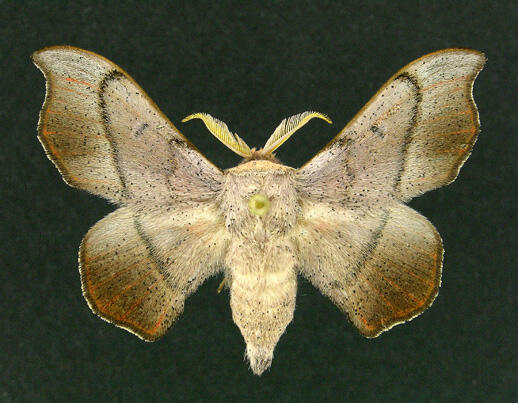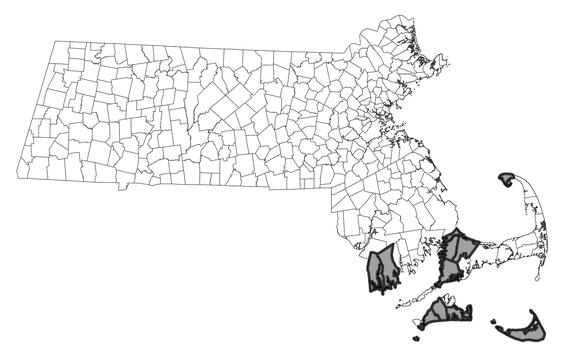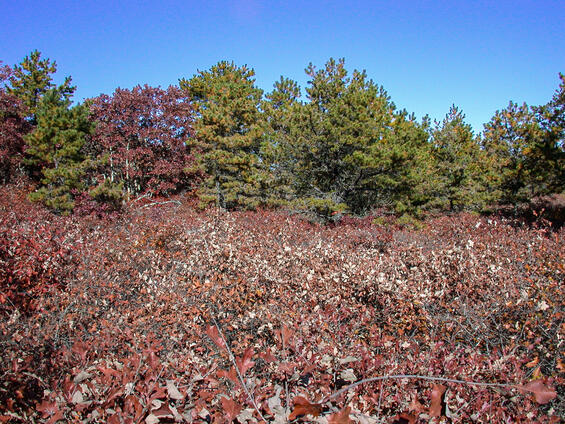- Scientific name: Cicinnus melsheimeri
- Species of Greatest Conservation Need (MA State Wildlife Action Plan)
- Threatened (MA Endangered Species Act)
Description

Melsheimer's sack-bearer (Cicinnus melsheimeri)
Melsheimer’s sack-bearer (Cicinnus melsheimeri) is a mimallonid moth with a wingspan of 35-50 mm (1.4-2.0 in) (Covell 1984). The forewing is hooked at the tip, pale, grayish-pink in color, becoming brown toward the outer margin, and overlaid with black speckling. The gray postmedial line is straight, curving inward near the costal margin; the antemedial line is also gray, but toothed and curving more sharply inward at the costa. The reniform spot is a small, gray dash. Like the forewing, the hind wing is pale, grayish-pink in color, becoming brown toward the outer margin, overlaid with black speckling; the postmedial line is gray and straight. On both the forewing and hind wing, the upper layer of scales is underlaid with bright orange, particularly toward the outer margin, which becomes more apparent as the wings wear. The head, thorax, and abdomen match the pale, grayish-pink of the inner portions of the wings, and are also overlaid with black speckling.
Life cycle and behavior

Adult moths fly in June and early July, with the peak flight in late June. Larvae feed on scrub oak (Quercus ilicifolia) from summer through fall, constructing a portable, protective shelter (“sack”) out of leaves and silk. Larvae overwinter and pupate in the spring.
Distribution and abundance
Melsheimer’s sack-bearer is found from Massachusetts south to Florida, and west to Wisconsin and Texas (Covell 1984). It is rare and local in the northern part of its range, more common from the New Jersey pine barrens southward. In Massachusetts it is restricted to Cape Cod, the offshore islands, and southern Plymouth and Bristol Counties.

Distribution in Massachusetts.
1999-2024
Based on records in the Natural Heritage Database.
Habitat
Melsheimer’s sack-bearer is more ecologically generalized southward, but in Massachusetts it is restricted to sandplain pitch pine-scrub oak barrens, especially scrub oak thickets. It may also be found in shrubby grasslands and heathlands with a component of scrub oak.
Healthy habitats are vital for supporting native wildlife and plants. Explore habitats and learn about conservation and restoration in Massachusetts.

Sandplain pitch pine-scrub oak barrens habitat with sparse trees and abundant scrub oak, ideal habitat for Melsheimer’s sack-bearer. Habitat managed by TNC at Medicine Lots Preserve.
Threats
Melsheimer’s sack-bearer is threatened by habitat loss and fire suppression in its disturbance-dependent habitats, in particular sandplain pitch pine-scrub oak barrens. Other potential threats include introduced generalist parasitoids, aerial insecticide spraying, non-target herbicide application, and off-road vehicles. The effect of a warming climate may not be detrimental to this species in Massachusetts; its range extends south to Florida, suggesting adaptation to warm temperatures.
Conservation
Land protection and habitat management are the primary conservation needs of this species in Massachusetts. In particular, sandplain pitch pine-scrub oak barrens should be conserved, restored, and managed to maintain habitat for this species and the entire suite of rare and threatened species dependent on such habitat.
Survey and monitoring
The distribution of Melsheimer’s sack-bearer in coastal sandplain pitch pine-scrub oak barrens is well documented. Known populations of this species should be surveyed to document persistence at least once every 25 years; every 10 years is more desirable when practicable.
Management
Management of sandplain pitch pine-scrub oak barrens benefits a suite of rare and threatened species, and habitat condition should be monitored and management adapted as needed. For Melsheimer’s sack-bearer, open barrens with a shrub layer including scrub oak (Quercus ilicifolia) is of particular importance.
Research needs
The natural history and conservation needs of Melsheimer’s sack-bearer are relatively well known. However, as with other species with a geographic range mostly south of Massachusetts, the future effects of a warming climate on this species are unpredictable and should be documented.
References
Covell, C.V. 1984. A Field Guide to Moths of Eastern North America. Peterson Field Guide Series. Houghton Mifflin, Boston, Massachusetts. 496 pp.
Contact
| Date published: | March 14, 2025 |
|---|